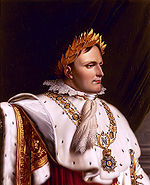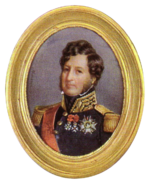- Mesures usuelles
-
Mesures usuelles (French for customary measurements) were a system of measurement introduced by Napoleon I in 1812 to act as compromise between the metric system and traditional measurements. The system was restricted to use in the retail industry and continued in use until 1839.
Contents
Rationale behind the new system
The French First Republic's introduction of the metric system into France was poorly managed by modern standards. It was done district by district between 1795 and 1800, with Paris being the first district to change. Although thousands of pamphlets were distributed, the Agency of Weights and Measures which oversaw the introduction underestimated the work involved. Paris alone needed 500,000 metre sticks, yet one month after the metre became the sole legal unit of measure, the agency had only 25,000 in stock.[1] This, combined with the excesses of the Revolution and the high level of illiteracy, made the metric system unpopular. Many people still thought in mostly non-decimal terms using the fractional subdivisions of the previous system: a livre (pound) was thought to be necessarily divided into sixteen onces (ounces) and a toise (fathom or double-yard) into 72 pouces (inches), as though these were absolute concepts.
Napoleon I, the French Emperor, disliked the inconvenience of surrendering the high factorability of traditional measures in the name of decimalisation, and recognized the difficulty of getting it accepted by the populace.[2] Under the décret impérial du 12 février 1812 (imperial decree of 12 February 1812), he introduced a new system of measurement, the mesures usuelles or "customary measures", for use in small retail businesses. However, all government, legal and similar works still had to use the metric system and the metric system continued to be taught at all levels of education.[3][4]
The prototypes of the metric unit, the kilogram and the metre, enabled an immediate standardization of measurement over the whole country, replacing the varying legal measures in different parts of the country, and even more across the whole of Europe. The new livre (known as the livre métrique) was defined as five hundred grams, and the new toise (toise métrique) was defined as two metres. Products could be sold in shops under the old names and with the old relationships to one another, but with slightly different absolute sizes. This series of measurements was called mesures usuelles.
Napoleon's decree was revoked during the reign of Louis Philippe by the loi du 4 juillet 1837 (law of 4 July 1837). This took effect on 1 January 1840, and reinstated the original metric system, thus bringing the system of mesures usuelles to an end.[3]
The permitted units
The law authorised the following units of measure:[5]
- The toise (fathom) was defined as two metres and was divided into 6 pieds, or "feet" and 72 pouces (inches). The pouce was divided into 12 lignes, or (lines). The pied and pouce, at 333.3 mm and 27.88 mm were about 2.6% larger than the previous Parisian measures and 9% larger than their British counterparts.
- The aune (ell), used to measure cloth, was defined as 120 centimetres, and divided into the demi aune (half an ell) and the tiers aune (third of an ell). It was 1.3% larger than l’aune de Paris (1.1848 m) and 5.0% larger than its English counterpart (45 inches).[6]
- The litre was subdivided like an English quart, into demis (literally, "halves", being the equivalent of a pint of about sixteen fluid ounces), quarts (literally, "fourths", being the equivalent of a cup of about eight fluid ounces), huitièmes (literally, "eighths") and seizièmes (literally, "sixteenths", of about two fluid ounces).
- The boisseau, (bushel), was redefined as being an eighth of a hectolitre and with associated measures double-boisseau, demi-boisseau and quart-boisseau (double, half and quarter bushels respectively). The original boisseau, like the English bushel, varied depending on the commodity for which it was used and the region where is was used.
- The livre, (pound), was defined as 500 grams, divided into 16 onces, (ounces), each once being divided into 8 gros. Each gros being thought of as being composed of 72 grains, whose name is the same as in English. Hence, the livre was 9216 grains.[7] The livre and once were about 10% larger than their English counterparts, while the grain was 17% less than its English counterpart.
The mesures usuelles did not include any units of length greater than the toise - the myriamètre (10 km) remaining in use throughout this period.[7]
See also
- French units of measurement
- History of measurement
- History of the metric system
- International System of Units
References
- ^ Adler, Ken (2002). The Measure of all Things - The Seven -Year-Odyssey that Transformed the World. London: Abacus. p. 269. ISBN 0 349 11507 9.
- ^ Napoleon I (19 December 1809). "Letter to Général Clarke, duc de Feltre". Correspondance de Napoléon Ier: publiée par ordre de l'empereur Napoléon III.. http://books.google.co.uk/books?id=cf1BAAAAYAAJ&pg=PA91&dq=je+me+moque+des+divisions+d%C3%A9cimales&cd=1#v=onepage&q=je%20me%20moque%20des%20divisions%20d%C3%A9cimales&f=false. Retrieved 2011-02-10. "Je me moque des divisions décimales [I ridicule decimal division]"
- ^ a b Denis Février. "Un historique du mètre" (in French). Ministère de l'Economie, des Finances et de l'Industrie. http://www.industrie.gouv.fr/metro/aquoisert/metre.htm. Retrieved 2011-03-10.
- ^ For example the engineering textbook, Stéphane Flachat (1835). Traité élémentaire de méchanique industrielle. Paris. http://books.google.co.uk/books?id=ghbWAAAAMAAJ&pg=PA33&lpg=PA33&dq=Puissance+poncelet#v=onepage&q=Puissance%20poncelet&f=false. Retrieved 2011-02-17.
- ^ Hallock, William; Wade, Herbert T (1906). "Outlines of the evolution of weights and measures and the metric system". London: The Macmillan Company. pp. 66–69. http://www.archive.org/stream/outlinesofevolut00halluoft/outlinesofevolut00halluoft_djvu.txt.
- ^ Thierry Sabot (1 October 2000). "Les poids et mesures sous l’Ancien Régime [The weights and measures of the Ancien Régime]" (in French). histoire-genealogie. http://www.histoire-genealogie.com/spip.php?article396. Retrieved 2011-02-10.
- ^ a b Wolfgang Appell (2002). "Königreich Frankreich [Kingdom of France]" (in German). Amtliche Maßeinheiten in Europa 1842 [Official units of measure in Europe 1842]. http://home.fonline.de/fo0126/geschichte/groessen/mas10.htm. Retrieved 2011-02-10Website based on Alte Meß und Währungssysteme aus dem deutschen Sprachgebiet ISBN 3-7686-1036-5
Systems of measurement Metric systems Natural units Geometric · Planck · Stoney · Lorentz–Heaviside · Atomic · Quantum chromodynamical
Conventional systems Astronomical · Electrical · Temperature
Customary systems Avoirdupois · Apothecaries' · British Imperial · Burmese · Canadian · Chinese · Cornish · Danish · Dutch · English · Finnish · French · German · Hindu · Hong Kong · Irish · Japanese · Maltese · Norwegian · Pegu · Polish · Portuguese · Romanian · Russian · Scottish · Spanish · Swedish · Taiwanese · Tatar · Turkish · Troy · United States
Ancient systems Greek · Roman · Egyptian · Hebrew · Arabic · Mesopotamian · Persian · Indian
Other systems Non-standard · Mesures usuelles · N-body
Categories:- Systems of units
- Science and technology in France
Wikimedia Foundation. 2010.


